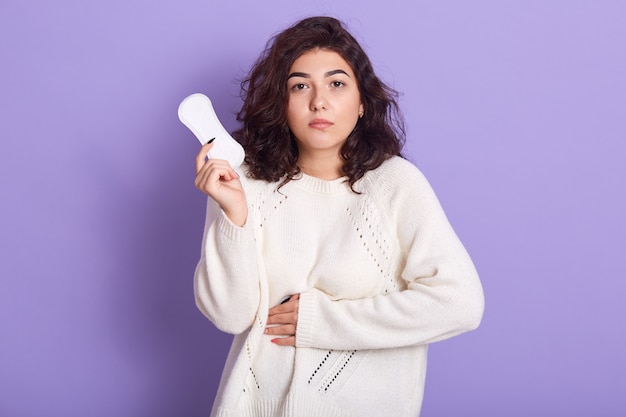
Brown vaginal discharge refers to spotting or fluid with a brownish or reddish brown color coming from the vagina. This happens because blood in the fluid turns brown as it gets older. Typically, brown discharge isn’t something to worry about, but if it’s caused by an infection, treatment may be necessary.
There are several common reasons for brown spotting, including hormonal changes, perimenopause, pregnancy, or ovulation. While these are often normal, there are instances where brown discharge might indicate a more serious issue that requires medical attention.
### Causes of Brown Vaginal Discharge
Brown or reddish-brown discharge can happen for various reasons, some of which are harmless while others could signal serious health problems, like infections or symptoms of vaginal cancer. Here are some potential causes:
**1. Ovulation**
During ovulation, an egg is released, and if it meets sperm, pregnancy becomes possible. Hormonal changes during this phase, such as a spike in estrogen followed by an increase in progesterone, can sometimes lead to brown discharge. This is due to the uterine lining growing but not yet fully developing in thickness.
**2. Perimenopause**
Perimenopause marks the transition to menopause. During this phase, periods become irregular and may occur months or even years apart. The discharge often occurs due to the buildup of old blood, which appears brown when released. Perimenopause usually begins between ages 45–55 but may start earlier for some women.
**3. Periods**
You might notice brown discharge at the start or towards the end of your period. This is normal and happens when older blood takes longer to exit the body.
**4. Implantation**
In early pregnancy, when a fertilized egg implants in the uterus, hormonal changes can lead to brown spotting. While not all women experience this, noticing brown discharge around the time you expect your period could suggest early pregnancy. However, only a pregnancy test can confirm it.
**5. Pelvic Inflammatory Disease (PID)**
PID is a serious sexually transmitted infection that can cause pain, burning during urination, foul-smelling discharge, and even fertility issues if untreated. Brown discharge sometimes accompanies this condition, and immediate medical attention is recommended.
**6. Hormonal Fluctuations**
Brown discharge can occur due to hormonal changes that happen during menstrual cycles, ovulation, early pregnancy, or conditions like polycystic ovary syndrome (PCOS) and perimenopause.
**7. Stress**
High stress levels can cause hormonal imbalances, resulting in occasional brown spotting. While temporary, reducing stress through methods like yoga or meditation can help resolve this.
### Treatment for Brown Vaginal Discharge
If brown discharge lasts only a day or two, it’s usually harmless. However, if it persists beyond three days, occurs with swelling, pain, itching, cramps, back pain, heavy flow, or dark blood during periods, it may indicate an underlying health issue that requires immediate medical attention.
Before beginning any treatment, a doctor will often perform a thorough examination to determine the cause and recommend the appropriate treatment based on your condition.
**1. Bacterial Vaginosis (BV)**
For pregnant women experiencing brown discharge due to BV, a doctor may prescribe medications such as metronidazole or topical treatments to prevent complications like miscarriage. It’s important to treat both the patient and their partner in such cases.
**2. Vulvovaginal Candidiasis**
Non-pregnant women with brown discharge caused by candidiasis may be treated with antifungal medications like fluconazole. If the issue persists despite treatment, further medical intervention may be necessary.
### Home Remedies for Managing Brown Vaginal Discharge
In addition to medical treatments, maintaining good hygiene and making lifestyle changes can help reduce brown discharge:
– Keep the vaginal area clean and change tampons frequently.
– Avoid inserting objects into the vagina to prevent infections.
– Wear cotton underwear and avoid synthetic or tight undergarments.
– Avoid scented soaps or powders, as they can irritate the area and lead to infection.
– Include iron-rich foods in your diet to prevent anemia-related discharge.
– Reduce stress through relaxation techniques like yoga or meditation.
– Eat a balanced diet to strengthen your immune system.
### Frequently Asked Questions
**Why is my discharge brown?**
Brown discharge often occurs because of old blood leaving your body.
**Am I pregnant if I’m noticing brown discharge?**
Brown discharge could indicate pregnancy during implantation, but this isn’t always the case. A pregnancy test can confirm if you’re pregnant.
**Why does my brown discharge have a bad smell?**
A foul-smelling brown discharge can be a sign of infection, such as PID, which requires immediate treatment.
**Why does brown discharge appear at the end of my period?**
This is usually due to leftover endometrial tissue exiting the uterus and is not cause for concern.
**Why does brown discharge occur before my period starts?**
Leftover tissues from your last cycle or hormonal changes might cause spotting before your period begins.
**Why am I seeing brown discharge between periods?**
This is often linked to ovulation and is typically normal.
Determining whether brown discharge is normal or linked to a health issue depends on your medical history and symptoms. If you’re unsure or experiencing other concerning signs, consult a doctor for proper treatment to address any underlying conditions.